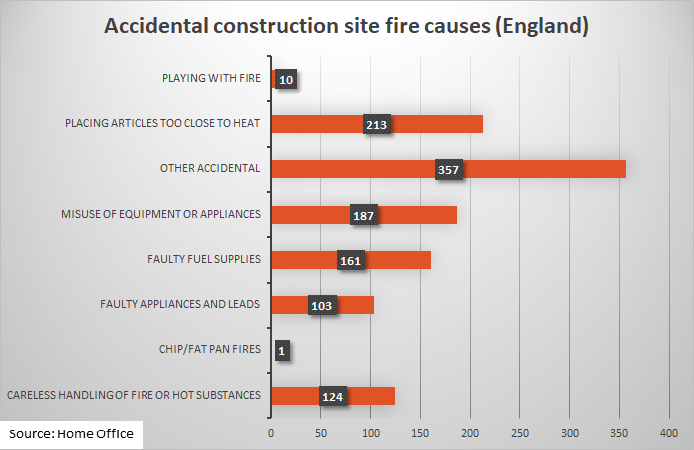Combatting fires on construction sites

The answer is not complex, the answer is to begin training, says Adam Richardson, Operations and Content Coordinator at the Fire Industry Association (FIA).
Following on from the news story on the shocking fire that damaged Kokos Nightclub in London, we explore the challenges associated with fires on construction sites with the insights from statistics provided by the Home Office. This article will conclude by looking at how we can reduce the number of fires on construction sites as an industry.
Five-year overview
The construction industry’s performance has improved over the past decade, though the rates of death, serious injury and ill health for construction site workers are still too high. When construction activities are not adequately controlled, children and other members of the public can also be killed or injured, and property adjacent to construction sites be put at risk – for example, from a site fire large enough to spread off-site.
Fires on construction sites can be categorised in two key ways: intentional and accidental. However, when consulting the statistics for fires on construction sites in England over the last five financial years it can be seen that there has been a 9.6% increase in the number of fires. An increase in construction site fires is totally undesirable. Though, it is important to appreciate the need for more research to give this figure greater context and thus relevance. For instance, if the number of construction sites increased by more than 10% over the last five years, that would change how we would view the 9.6% increase in fires over five years.
Home Office Statistics Fires on construction sites in England (2014-2019):
2014/15 – 333
2015/16 – 397
2016-17 – 346
2017/18 – 410
2018/19 – 365
On a more promising note, over the last two years there has been a 12.3% decrease in construction site fires from 2017/18 to 2018/19. Whilst it is impossible to predict what this year’s statistics will be, we can hope that with an increasing amount of people taking training to become more competent, coupled with technology and our use of it getting better, that in 2019/20 fires on construction sites will continue to decrease.
Deliberate or accidental?
We can assume that most fires started on construction sites are due to human error. Whilst this is unacceptable and disappointing, it is at the same time uplifting as it gives us an opportunity to change, adapt and improve to solve this issue. Upon looking into the causes of fires on construction sites, it can be seen that accidental causes comprises 62.5%, whilst deliberate actions account for 37.5%.
Danny Green, Fire Brigades Union national officer, commenting on deliberate causes of fires on construction sites, expressed that these statistics are “deeply concerning”. He followed on to say: “Deliberately caused fires put the lives of workers, firefighters, and members of the public at risk. Fire safety is crucial in all workplaces, but construction sites carry a particular risk. Regular fire safety inspections are vital to ensuring that construction sites and workers remain safe.”
As a result, it would appear that we as a society don’t have a criminal problem but a problem regarding competency – a problem we can tackle through training.
The above graph shows the specific actions that make up the accidental causes of fires on construction sites. These causes can be reduced over time by ensuring that those who work on construction sites undertake appropriate training.
“Construction site fires hit the headlines when a famous, or prestigious building is involved, but many more occur that don’t make the news. Accidents do happen, but with the data from the Home Office, we at least have a starting point in attempting to reduce the number of incidents, by helping to educate those people who work on the construction and refurbishment of buildings,” highlights Neil Budd, FIA Technical Manager.
Part of the answer primarily lies in focussing on undertaking more thorough and comprehensive risk assessments of construction sites, ensuring that these accidental causes are less likely to happen. It is also important to continue to improve our detection and suppression systems across all sites.
A strong focus is required to prevent these disasters. Whether you work in risk assessment and FD&A or detection and suppression you can take a step towards reducing these disasters whilst benefitting personally. The answer is not complex, the answer is to begin training and in doing so we will create a more competent community of construction professionals.
Based in Northern Ireland? The FIA is set to host its first Northern Ireland Industry Conference in April 2020.
The Fire Industry Association has called over many years for improvements to the regulatory environment and competency levels in the UK fire safety industry. The FIA’s colours have long been firmly nailed to its mast with a range of industry-best training courses for individuals. In doing so, it takes responsibility for both enabling competency in the sector and providing assurance that FIA members deliver credibility and the very highest quality in the provision of products and services.
This article first appeared on the FIA’s website.
FIREX 2020 at ExCel London on 19-21 May
FIREX International is your chance to stay up-to-date with the latest technologies and legislation within the fire and life safety industry. Join the fire safety community at FIREX 2020 at ExCel London on 19-21 May to source hundreds of solutions across passive fire protection, fire prevention and detection; sprinkler and suppression systems, emergency lighting and much more.


